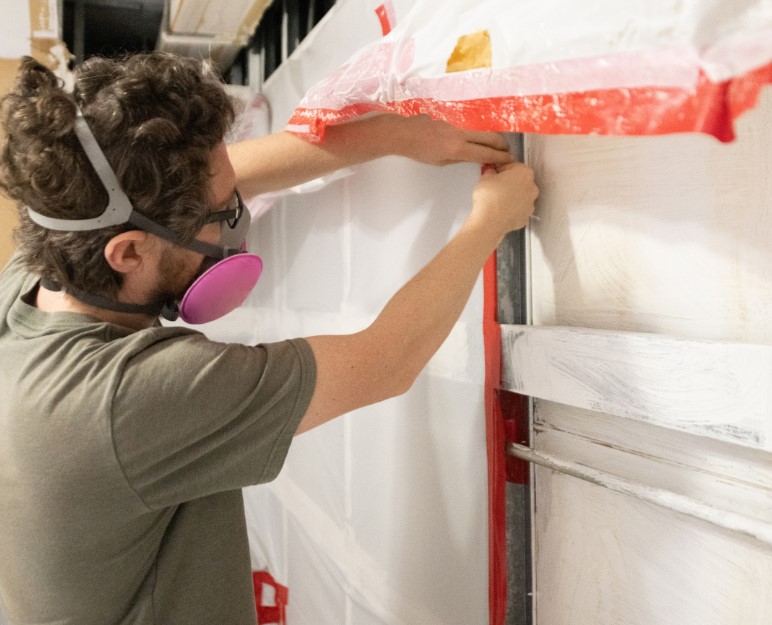Mold growth in homes can cause health problems and damage to your property.
Mold remediation is the solution. It’s a process that removes mold and prevents its return.
But what does mold remediation cost? The answer isn’t straightforward.
Mold remediation costs can vary depending on the size of the infestation and the type of mold.
This article will guide you through these costs. We’ll discuss what influences them and how to budget for them.
By the end, you’ll have a clearer understanding of mold remediation costs. You’ll be better prepared to tackle any mold issues in your home.
Understanding Mold Remediation
Mold remediation is more than just cleaning the visible mold. It involves a comprehensive approach to addressing the root causes.
The process starts with a thorough inspection. Professionals assess the extent and type of mold present.
Containment is essential to prevent the spread of spores. This step ensures that unaffected areas remain safe.
Air filtration systems help capture airborne spores. These systems play a crucial role in safeguarding indoor air quality.
Finally, cleaning and disinfecting of affected areas are performed. This step removes the mold and prevents future growth. Proper mold remediation ensures a healthier living environment.
Factors Influencing Mold Remediation Costs
Mold remediation costs can vary significantly. Several factors contribute to the final removal cost.
The size of the affected area is a primary factor. Larger infestations generally incur higher costs.
Location also plays a crucial role. Mold in hidden areas may require more invasive procedures.
The type of mold impacts remediation costs. Some molds are more challenging and costly to remove.
The severity of infestation is another key factor. Extensive damage may involve more complex remediation efforts.
Accessibility of the mold affects pricing. Hard-to-reach areas can increase labor and equipment costs.
Material replacement is often necessary. Damaged building materials may need to be replaced.
The geographic region will influence the cost due to varying labor rates. Areas with higher living costs often have higher remediation prices.
Insurance coverage can reduce personal expenses. Check your policy to see if mold issues are included.
The expertise of the service provider affects pricing. Reputable professionals often charge more but ensure better results.
Size and Location of Mold Infestation

The size of the mold area significantly affects costs. Larger infestations require more resources and labor.
Bigger areas mean more cleaning, containment, and materials. Hence, expect higher costs with increased size.
The location of the mold is another important factor. Mold in basements or attics often costs more to treat.
Hidden mold in walls or crawl spaces may increase expenses. Accessing these areas requires specialized tools and skills.
Having mold in a visible, easy-to-reach area may reduce costs. Accessibility simplifies the remediation process, lowering labor costs.
Type of Mold and Severity of Infestation
Different molds require specific treatment approaches. Black mold is more hazardous and thus costlier to remediate.
Toxic molds necessitate stringent safety measures. This increases labor and material costs during remediation.
The severity of the infestation significantly impacts pricing. Extensive infestations demand more rigorous and prolonged treatment.
The mold that has spread widely necessitates a comprehensive cleanup. Severe cases might involve tearing out and replacing materials.
Milder mold issues may cost less to address. Quick and localized intervention can reduce overall expenses.
Accessibility and Material Replacement
Accessibility challenges can heighten mold remediation costs. Mold behind walls or under flooring is harder to access.
Hard-to-reach areas require more effort and specialized tools. This translates to increased labor time and higher costs.
Material replacement often accompanies mold remediation. Mold can damage drywall, carpet, or insulation, leading to extra costs.
Replacing these materials ensures no mold remnants are left behind. This process is crucial for preventing future infestations.
Ultimately, accessibility and material replacement both play significant roles. These factors can substantially affect remediation expenses.
Average Costs of Mold Remediation
Understanding the average costs of mold remediation can help homeowners plan better. Prices fluctuate based on various factors.
Typically, mold remediation costs range between $500 and $6,000. This broad range accounts for different mold types and severity levels.
For moderate cases, most homeowners spend around $2,000 to $3,500. However, complex situations can exceed these averages.
If dealing with severe infestations, costs might rise significantly. Such scenarios involve comprehensive cleaning and material replacement.
Here’s a quick breakdown of average costs:
- Minor Mold Issues: $500 – $1,500
- Moderate Mold Infestation: $1,500 – $3,000
- Severe Mold Problems: $3,000 – $6,000+
These estimates are guides, not fixed prices. Actual expenses depend on specific conditions.
Consulting a professional for an accurate quote is advisable. Obtaining several estimates can help in understanding potential costs better.
By Area Size
The size of the affected area greatly impacts costs. Small areas typically result in lower expenses.
Remediating mold in a small closet or bathroom might cost between $500 and $1,000. For larger spaces like basements, prices increase.
Extensive infestations covering a large area can exceed $3,000. Area size is a crucial factor in determining final costs.
By Location in the Home
Location within the home also affects mold remediation expenses. Mold found in kitchens and bathrooms might be less costly to remove.
These are often accessible spaces, easing the remediation process. Costs might range from $1,000 to $2,000 in such areas.
Attics and basements often present more challenges. Their difficult access can increase labor and equipment costs.
Mold behind walls or in HVAC systems can be particularly expensive. Such hidden problems might push costs beyond $3,000.
Location matters because it influences the complexity of the job. More challenging locations demand more effort and thus, higher costs.
Professional Mold Remediation vs. DIY

Choosing between professional mold remediation and DIY approaches depends on several considerations. Each option has distinct advantages and drawbacks.
Professionals bring expertise and safety. They are skilled in identifying mold types and effective removal methods. This minimizes health risks and prevents further spread.
DIY can be cost-effective for minor issues. However, it may not address the full extent of infestation.
The following list outlines key differences:
- Professional Remediation:
- Comprehensive and thorough
- Higher upfront cost
- Reduces long-term health risks
- DIY Approach:
- Lower cost for small areas
- Risk of incomplete removal
- Potential for mold recurrence
For large infestations, professional help is advisable. Health and property safety should be a priority. Professional services ensure thorough solutions, albeit at a higher cost.
Budgeting for Mold Remediation
Planning ahead can help in effectively managing mold remediation costs. Understanding potential expenses aids in creating a realistic budget.
Start by assessing the severity of the mold problem. This will guide estimated costs. Consider both immediate and long-term expenses.
Here are some key steps for budgeting:
- Research average remediation costs in your area.
- Consult multiple professionals for detailed estimates.
- Account for potential additional costs, such as repairs or temporary relocation.
Remember that cutting corners on remediation can lead to more expenses later. Investing in quality services is crucial. It’s a decision that protects both health and property value.
Getting Multiple Quotes
Seek multiple estimates from licensed mold remediation experts. This helps compare mold removal prices and identify fair market rates.
Each professional may provide different solutions and costs. Review their proposals carefully. Understanding these differences can impact your decision-making.
Don’t choose solely based on the lowest price. It’s important to balance cost with service quality.
Insurance and Financing Options
Check if your homeowners insurance covers mold remediation costs. Policies vary, and coverage depends on the source of mold.
Contact your insurer to discuss potential claims. Be prepared to provide documentation of the issue and estimated costs.
Some companies offer financing plans to help manage payments. Exploring these options can ease financial stress and ensure timely remediation.
Preventing Future Mold Issues

Effective mold prevention saves costs and protects health. It requires addressing the root causes of moisture in your home.
Regular inspection and maintenance are essential. Detect problems before they escalate into mold issues.
Control humidity levels to reduce mold growth risk. Use dehumidifiers and ensure proper ventilation in prone areas like bathrooms and basements.
Here are preventive measures to consider:
- Install exhaust fans in moisture-prone areas.
- Regularly clean and maintain gutters to prevent leaks.
- Fix plumbing leaks promptly to eliminate water sources.
Using mold-resistant materials during home renovations can further deter future infestations. Choose wisely when making such improvements. Preventive actions not only save money but also safeguard the home environment against potential mold problems.
The Value of Professional Mold Remediation
Addressing mold issues promptly is crucial for health and property integrity. Professional remediation ensures thorough and safe removal.
Expert services provide the peace of mind that comes with tackling the problem’s source. Avoid recurring mold troubles by trusting the experts.
Investing in professional mold remediation is a step toward a healthier living environment for everyone involved.
For expert mold remediation services in PuroClean Emergency Restoration Services.




 PuroClean Emergency Restoration Services
PuroClean Emergency Restoration Services